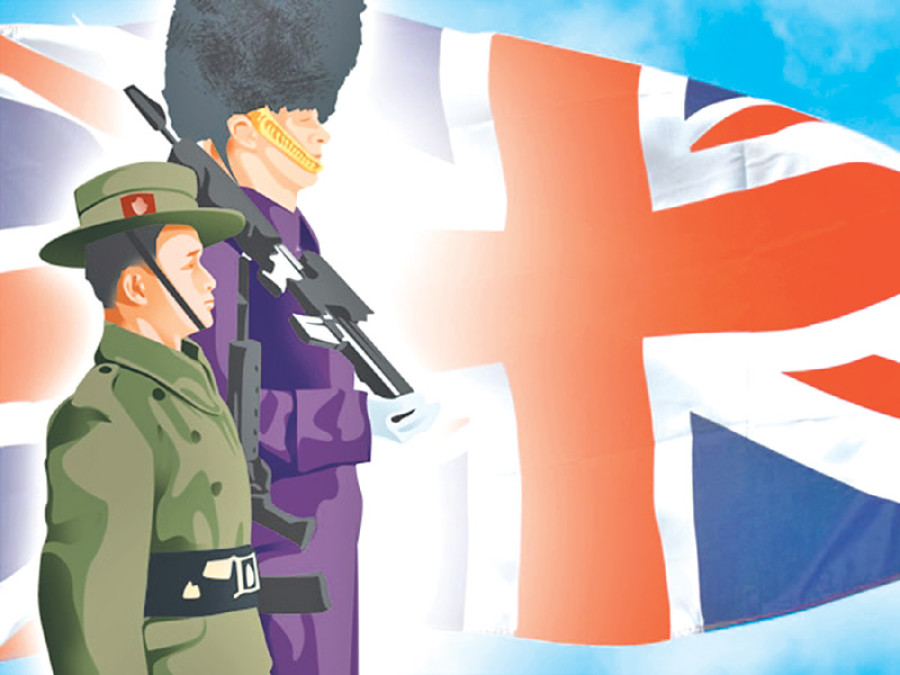National
200 years of Nepal-UK ties
Nepal’s integration in the global market has a long history, one in which the Gurkhas played a pivotal role
Deepak Thapa
The end of 2016 brings to a close the bicentenary of the establishment of diplomatic ties between Nepal and the United Kingdom. Granted that the Treaty of Sugauli of 1816 was actually signed between Nepal and the British East India Company, with Imperial Britain having taken over from the Company only after the latter’s disastrous handling of the 1857 uprising in India, the earlier date serves very well as a marker of the historical links between the two countries.
This relationship is significant for a number of reasons. For one, it laid the basis for the creation of the Rana client state in Nepal for the British. Second, it facilitated the export of sturdy young men from Nepal to fight the British Empire’s wars around the world. Third, in acknowledgment of that contribution of men, particularly in World War I, the 1923 Treaty of Friendship was signed, which granted Nepal recognition by a world power as an independent country.
Nothing, however, symbolises the ties between the two countries than the humble Gurkha. It was brought home yet again in December 2015 at the ceremony that kicked off the 200 years’ celebrations. Addressing the reception hosted for Kamal Thapa, the then foreign minister, who had reached London for the occasion, the British Minister of State for Asia, Hugo Swire, said: “As the son-in-law of a former Gurkha officer, Nepal is particularly close to my heart…”
Impact on Nepal
Studying the papers squirreled away by Newar merchants in the erstwhile trading town of Bandipur, American anthropologist Stephen Mikesell has written about how the forces of mercantile capitalism represented by the East India Company had penetrated the hills of Nepal even by the early years of the 19th century. It is not clear if that would have happened as part of the natural course of events, or if the Treaty of Sugauli provided inroads into a new market, or if it was a combination of both. What is without doubt is that the monetisation of the Nepali economy would not have been possible without all those Gurkha soldiers bringing back hard currency to Nepal.
As we were reminded after the demonetisation by the Indian government rendering the 500- and 1000-rupee notes worthless, Indian currency serves as legal tender for all kinds of market transactions in large parts of Nepal, particularly in the west. Hence the dilemma before the Nepali government about what to do with all the Indian notes in circulation in the market (although it has been couched only as savings ferreted away in trunks in Nepali homesteads).
Not much is known about the early economic impacts of recruitment of the Gurkhas into British service. We have to fast forward to 100 years later, to the immediate aftermath of World War I for a better understanding of the kind of transformation this arrangement wrought on Nepali society. The first of the five-volume Tyes Bakhatko Nepal (Nepal of Those Days) by Bhim Bahadur Pandey provides a detailed account of what happened at the time.
Origins of dependency
According to Pandey, and I paraphrase extensively, the 200,000 Gurkhas who fought in World War I brought back an average of 500 Indian rupees. This totalled around 130 million rupees nationally, which would translate to around 13 billion rupees at the time the book was published (in 1982). For a country that could only sometimes raise an annual revenue of around 10 million rupees or so, that represented a huge influx of capital into the Nepali hinterland—of the kind never before seen.
These are only rough estimates and Pandey has based his calculations on all 200,000 soldiers fighting an equal length of time for the British, whereas recruitment would have happened in phases and there were those who would have come back home with no more than a pittance after only a few months’ service. Given his early life in Syangja, Pandey’s descriptions of life in village Nepal is restricted more to the Nutanwa-Butwal-Palpa trade corridor. But, by the same token, he would also have experienced first-hand the changes he writes about in his own home environs.
As they made their way up the trails literally distributing money, porter wages rose, the gaine minstrels began to receive money, eateries were established everywhere and the Thakali owners became rich. It was not only money that entered Nepal with the lahures, but mannerisms, all kinds of goods, styles of eating and dressing, and ways of thinking, all of which represented the entry of influences from across the seas into Nepal for the first time. The favoured phrase among the lahures was ‘Damn fool’. Village damsels learnt how to smoke, strike a match and kiss in the western style, writes Pandey.
And, as today, when remittances contribute a bulk of our GDP, a 100 years ago, land prices rose drastically since lahures had so much money to spend on any and everything. Thus, writes Pandey, land prices increased since even the cost of a small piece of land began to exceed savings made over generations. Further, instead of finding ways to make productive use of the money brought by the lahures by diverting it towards the little indigenous income-generating industry that existed such as cash cropping, animal husbandry, or a few cottage industries, seemingly to increase customs revenue the Rana regime granted permission to merchants to set up shop in the main border points and allowing the never-ending influx of consumer items into the country.
Pandey lists an eclectic mixture of items increasingly found in the market: Japanese tennis shoes, gowns, blankets, saris, bangles, cigarettes, beads, coconut, betel, matches, utensils, garam masala, etc. He argues that the entry of these readymade goods led to the demise of the small home-grown industry Nepal had at the time, and concludes that was the most damaging impact of World War I on Nepal.
Mikesell arrives at a similar conclusion from studying the books kept by merchants in the same region of Nepal that would have informed Bhim Bahadur Pandey’s observations. He writes that ‘the community in Nepal became increasingly mediated by the bazaar and merchants representing foreign industrial capitalist interests in the form of industrial commodities and mercantile profits…’ The integration of Nepal into the global market is thus of long provenance and playing the most pivotal role was the lowly Gurkha, a fact that certainly deserves more attention than given to it so far. After all, it is 200 years since that process began.




 6.12°C Kathmandu
6.12°C Kathmandu










%20(1).jpg&w=300&height=200)



